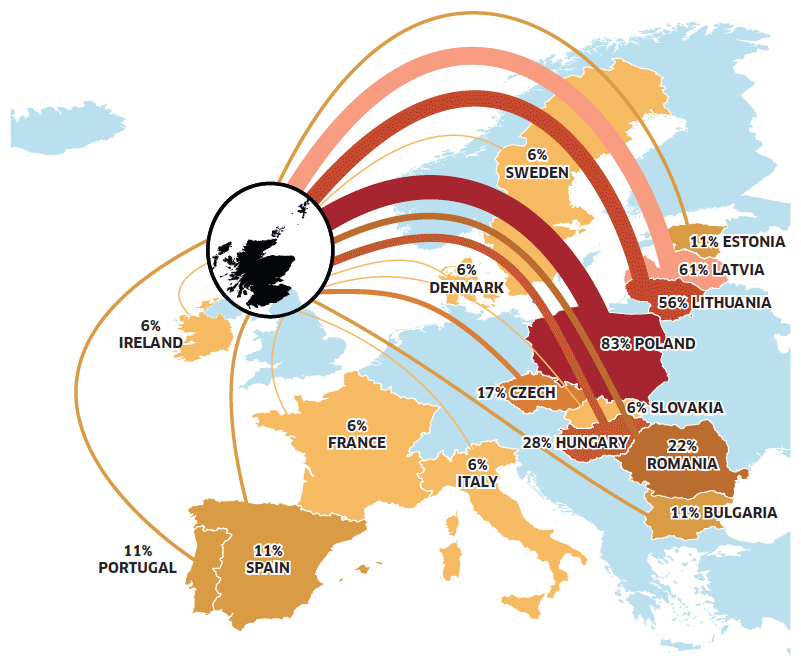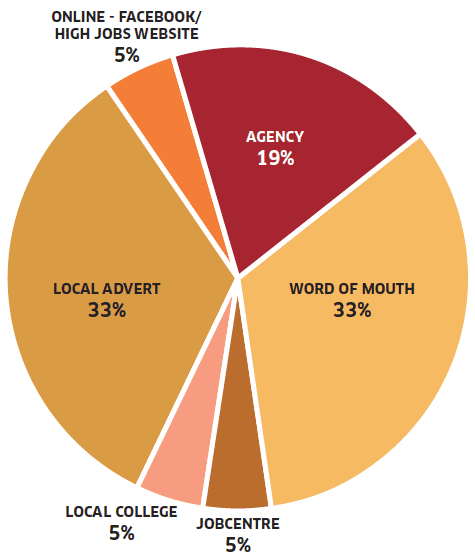Scotland's seafood processing sector: employment patterns
Employment patterns of non-United Kingdom (UK) European Economic Area (EEA) workers in Scotland's seafood processing sector.
Key Findings
A. Employment patterns
Of the 3,033 persons working in the 18 processing businesses surveyed, 86% worked on permanent contracts, 12% on non-permanent contracts via an agency and 2% on non-permanent contracts directly with the processing business (Table 1).
Table 1: Contract Type in Scottish Seafood Processing Sector (2016)
| Permanent (core staff) | Non-permanent - Direct | Non-permanent - Agency |
|---|---|---|
| 86% | 2% | 12% |
About 41% of the total workforce of the processing businesses surveyed were UK nationals, 58% were non- UK EEA nationals and just under 1% were non- EEA nationals (Table 1). Further breakdown showed 55% of the permanently employed staff were non- UK EEA nationals, 44% were UK nationals and 0.5% from non- EEA countries (Table 2). Non- UK EEA nationals totalled 81% of agency staff, UK nationals just under 17% and non- EEA nationals just under 2%. A much smaller proportion of workforce employed in the surveyed processors were non-permanent (2%), but directly contracted to the processing businesses (Table 1).
Table 2: Employment figures by nationality (2016)
| UK | EEA | Non- EEA | Total number of workers | |
|---|---|---|---|---|
| Permanent (core staff) | 44.3% | 55.3% | 0.5% | 2596 |
| Non-permanent - Direct | 60.0% | 33.3% | 6.7% | 60 |
| Non-permanent - Agency | 16.7% | 81.4% | 1.9% | 377 |
| Total by nationality | 41.1% | 58.1% | 0.8% | 3033 |
A breakdown by contract and processing sector found higher dependency in mixed/whitefish processing where 64% of the permanent workforce and 100% of agency staff were non- UK EEA nationals. This was followed by salmon processing with 50% of permanent and 63% of agency staff, and shellfish processing with 38% permanent but no agency staff, coming from EEA countries (Table 3).
Pelagic processors were the most dependent on EEA agency staff as they made up 100% of their non-permanent workforce (Table 3) and accounted for 43% of the surveyed pelagic processors total workforce. This was also the case for mixed processing, but the number of agency staff was small compared to their permanent workforce (2.5%), and the agency staff were employed to process pelagic species.
Table 3: Employment figures by nationality by main processing sectors (2016)
| Permanent | Non-permanent - Direct | Non-permanent - Agency | ||||||||||
|---|---|---|---|---|---|---|---|---|---|---|---|---|
| UK | EEA | Non- EEA | n | UK | EEA | Non- EEA | n | UK | EEA | Non- EEA | n | |
| Mixed | 35.0% | 64.5% | 0.5% | 1552 | 100% | 0% | 0% | 15 | 0% | 100% | 0% | 40 |
| Pelagic | 79% | 21% | 1% | 200 | 28.6% | 52.4% | 19% | 21 | 0% | 100% | 0% | 150 |
| Salmon | 49.8% | 50% | 0% | 647 | 76.9% | 23.1% | 0% | 13 | 33.7% | 62.6% | 3.7% | 187 |
| Shellfish | 62.4% | 38% | 0% | 189 | 45.5% | 54.5% | 0% | 11 | 0% | 0% | 0% | 0 |
Figure 2: Percentage of survey businesses who cited employing nationals from said country.

For the businesses who employed EEA staff, which was all but one facility in the Highlands, 83% said they employed Polish nationals; 61% of businesses employed Latvian nationals and; 56% employed Lithuanian nationals (Figures 2). As figure 2 demonstrates employees also included Hungarian, Romanian, Czech, Estonian, Portuguese, Spanish, Bulgarian, French, Italian and Irish nationals.
Non- EEA nationals made up a much lower proportion of workers (0.8%), and included nationals from Thailand, Brazil, Egypt, Russia, America, Nigeria, Pakistan, Moldova, Turkey and Tanzania.
B. Dependency on non- UK workers
Companies were asked to define how dependent they felt they were on non- UK employees and how this broke down between low and high-skilled workers. All pelagic businesses stated that their dependency was high for low-skilled employees and one third were highly dependent on high-skilled employees. The remaining two thirds had medium dependence and not dependent on high-skilled non- UK employees.
For shellfish businesses, three quarters stated that they had high dependency and one quarter had medium dependency on low-skilled non- UK employees. For high-skilled labour, high dependency was stated by a quarter of shellfish businesses while the remaining three quarters of shellfish businesses were not dependent on any high-skilled non- UK labour.
For salmon processing two thirds of businesses were highly dependent on low-skilled non- UK labour and one third not at all dependent. One third of salmon processors were highly dependent on high-skilled non- UK labour and one third not at all dependent. For mixed processing 50% of businesses were dependent on both high and low-skilled non- UK workers and one third stated themselves as having a medium dependency on both high and low-skilled non- UK workers.
Reasons given for classifying their dependency as high included: the high proportion that non- UK employees made to their business' total workforce; the inability to shift to more automated or mechanalised progresses e.g. fish filleting and therefore the need to retain experienced staff; low unemployment rates in the local area which makes local recruitment difficult, and; the high quality work ethic of EEA employees.
C. Skills
Businesses were asked to list the roles that non- UK workers undertook in their processing facilities and whether they classified them as low or high-skilled roles. Table 5 presents a list of the jobs that non- UK ( EEA and non- EEA) employees occupied in the processing facilities and presents the number of businesses who listed that role.
Table 5: Type of jobs undertaken by EEA and non- EEA employees and frequency cited by businesses
| Low-skilled | Number of businesses citing | High-skilled | Number of businesses citing |
|---|---|---|---|
| Factory operatives | 8 | Supervisors | 10 |
| Drivers | 5 | Managers (Office/Factory) | 8 |
| Filleters | 5 | Engineers | 6 |
| Cleaners | 4 | Quality Control | 6 |
| Production line | 4 | Accountant/Admin | 2 |
| Packing operatives | 4 | Translator | 1 |
| Forklift | 3 |
Most highly skilled roles occupied by non- UK nationals were supervisors (cited by 10 businesses) followed by managers (8), quality control (6) and engineers (6). Most of the low-skilled non- UK roles were factory operatives (in 8 businesses), fish filleters (5) and general drivers (5). Cleaners, production line and packing operatives were listed by 4 businesses and forklift drivers by 3 business. In the case of filleters, there was dispute as to whether they were high or low-skilled given the length of training required to develop the necessary speed and skill required for the role.
D. Recruitment patterns
Businesses were asked about how they recruited EEA workers. Two thirds of the surveyed businesses said EEA workers were recruited by local networks either via word of mouth (33%) or local advertising (33%) (Figure 3). A minority were recruited via agencies, mainly in Lithuania, although some interviewees stated it was becoming harder to recruit via agencies than in the past. Interviewees also mentioned other local recruitment mechanisms such as job centres, local colleges and online.
Figure 3: Method of recruitment for processing facilities

E. Implications of loss of non- UK EEA labour
When asked what impact restrictions on the free movement of people would have for their businesses, some respondents said there would be limited impact as they did not employ many non- UK workers. A small number of businesses said it would mean higher workload for the remaining staff and possibly less throughput which would impact on turnover. Some felt that they would not be able to get the quality of staff that they currently have which would affect the efficiency of the factories and pose health and safety risks. A couple of businesses said they would go back to using agency staff and employ more administration staff to handle visa requirements so they could still access reliable staff. Other businesses said they would explore potential investments in technology and more automation as well as moving some processes to different factories - assuming they had the workforce. The remaining businesses felt this be would a huge blow and considered it a direct and significant threat to business survival.
All surveyed businesses stressed the significant challenges around: maintaining the standards required by customers; that some processes cannot be easily automated to deliver high quality products ( e.g. fish filleting), and; there would be significant lead-in time and costs to implementing technology change.
Contact
There is a problem
Thanks for your feedback